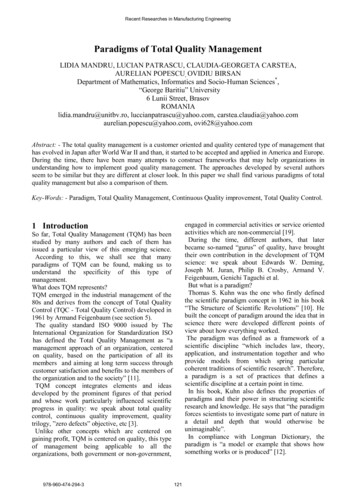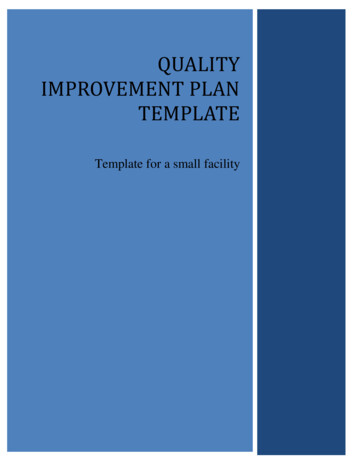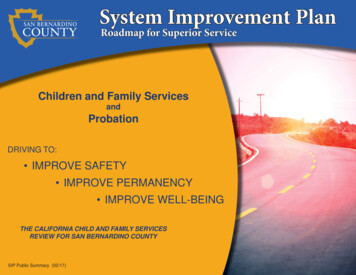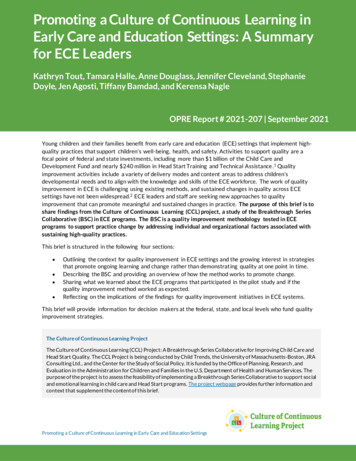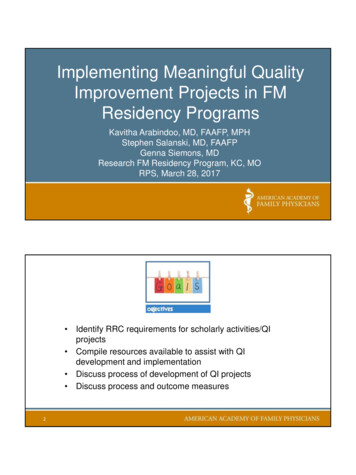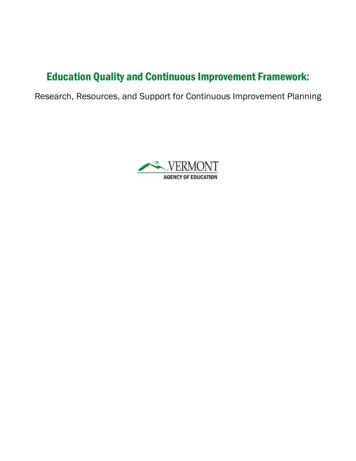
Transcription
QualityImprovementWorkbookQuality Improvement WorkbookPage 1
ContentsQuality Improvement Planning Tool .3Worksheet A: Forming a Team .5Worksheet B: Team Meeting Notes .7Worksheet C: Goal-Setting.8Worksheet D: Data Plan .9Worksheet E: The 5 Whys .11Worksheet F: Cause and Effect (Fishbone) Diagram .12Worksheet G: Current Process Analysis .15Worksheet H: Process Observation .16Worksheet I: SWOT Analysis .17Worksheet J: Assessment Summary .19Worksheet K: Process Improvement Plan .20Worksheet L: Implementation Strategy .21Worksheet M: Testing .22Worksheet N: Ongoing Monitoring.24Appendix A: Plan-Do-Study-Act (PDSA) Planning Worksheet–Example .25Appendix B: Action Plan—Guidance .27Appendix B: Example .28Appendix B: Action Plan.29Appendix C: Process Mapping .30Appendix D: Swim Lane Flowchart .31Appendix E: Process Observation Form: Workflow .32This Material was adapted by Health Services Advisory Group, the Medicare Quality Improvement Organization for Arizona, California, Florida, Ohio, and the U.S. Virgin Islands, under contractwith the Centers for Medicare & Medicaid Services (CMS), an agency of the U.S. Department of Health and Human Services, from material originally prepared by Ohio KePRO. The contentspresented do not necessarily reflect CMS policy. Publication No. QN-11SOW-C.3-02022018-01Quality Improvement WorkbookPage 2
Quality Improvement Planning ToolOrganization:Clinical Topic:Focus Area Within Topic:Start Date:Team Leader:This worksheet provides a structured framework in which to narrow down, collect data, and select and organize ateam for the problem area chosen. Worksheets A–N will help start the process of identifying an area forimprovement and forming a team to address that improvement. Please complete all steps and worksheets in thissection and then continue to Appendix A (Plan-Do-Study-Act).StepDate CompletedDetailsProceed to Worksheet A (Forming a Team).Create a team withappropriate staffmembers for addressingthis area. Involve staff members from different departments, units, and shifts. Ask for volunteers. Be sure to include executive leadership as appropriate.To organize team meetings:Proceed to Worksheet B (Team Meeting Notes). Take simple notes at team meetings and record next steps.Circulate Team Meeting Notes to team members at each meeting.Proceed to Worksheet C (Goal Setting).Determine goal forimprovement.Formulate a data plan. Goal should be clear, focused, and realistic.The entire team should know, understand, and “buy into” the goal. Collect data relevant to your goal.Record findings.After review, if the records indicate that your organization is meetingits goal for this area, repeat steps 2–3.After review, if the records indicate that your organization is notmeeting its goal for this area, proceed to the next step. Conduct an assessmentand root cause analysis.Define current process—identify what you arecurrently doing. Quality Improvement WorkbookSometimes there is more to the story than meets the eye. The righttool can help identify the true root cause of a problem. Choose toolsthat will help organize information about current care processes andoutcomesIdentify where and why the problem exists.Do not jump to conclusions; problems are often caused by poorsystems rather than an individual’s performance.Brainstorm all possible ideas and causes for the problem.Use the tools and worksheets in this workbook to assist your efforts.By targeting the true root cause, sustainable improvement can bemade. Summarize and discuss findings with the team (Worksheet J)Page 3
Quality Improvement Planning Tool (cont.)Develop change inprocess— identify animprovement based onthe root cause analysis.Develop implementationstrategy on a small scale.Proceed to Worksheet K (Process Improvement Plan). Change should be small and measurable.Proceed to Worksheet L (Implementation Strategy). Plan how improvement will be implemented.Proceed to Worksheet M (Testing). Implement improvement(pilot test).Start small with one unit or shift.Make change.Determine start/evaluation date.Proceed to Page 2 of Worksheet M (Test Evaluation). Evaluate tested change. Develop implementationstrategy acrossorganization.Implement improvedprocess acrossorganization. After change is implemented, review charts and collect data forcompliance.Evaluate dateDid change meet goal?If no revision is needed, plan organization-wide change utilizinginformation from Worksheet L (Implementation Strategy).Continue larger tests of change until team agrees that process changeis ready to implement fully within the organization. Implement tested change. Educate staff members. Make changes and communicate. Make the process visible.Proceed to Worksheet N (Ongoing Monitoring). Monitor improvement.Develop plan to review and monitor improvement.Review process and collect data.Make changes as necessary.Recognize and reward team!Celebrate successes with entire organization!Celebrate!Quality Improvement Workbook Recognize staff members’ contributions to improvement.Page 4
Worksheet A: Forming a Team“Teams always outperform an individual.”A team is a small group of people with complementary skills, committed to working together toward a commonpurpose, holding one another mutually accountable. The work of a project team focuses on system-level processesin order to achieve sustainable improvements. Identify all members who will work on this project.Teams should have three to four members who will plan, implement, and evaluate the work of the team.Roles of team members should include:– Process Owner: Holds direct responsibility and ownership of a particular process.– Support: Provides assistance, materials, information, or services needed to carry out the project.– Team Leader: Initiates the project and adds to the project team authority. Typically, the mostsenior member of the team.– Team Mentor: Participates on the project team and is responsible for carrying out actions withinthe project action plan.Assess current project team to ensure that it includes appropriate members from various levels of theorganization who work in areas related to the topic chosen for improvement. Include direct carestaff, administrators, supervisors, and ancillary departments such as pharmacy, nutrition, social service,therapy, and environment.Involve staff members from various shifts and units.Team MembersNamePositionContact InformationAlternates:Quality Improvement WorkbookPage 5
Worksheet A: Forming a Team (cont.) Provider meeting ground rules.– Start and end on time.– Use an agenda.– No sidebar conversations.– All ideas will be considered.– Include additional ground rules as agreed upon by team members.Identify time and place for short weekly meetings (no more than 30 minutes).– Team does not have to meet at same time and place each week.– Meetings can be more or less frequent, as needed.– Post meeting schedule in a place accessible to all team members.Meeting ScheduleDateQuality Improvement WorkbookTimePlacePage 6
Worksheet B: Team Meeting NotesTeam Members:Meeting Date:Team Goal:Main Points of DiscussionQuality Improvement WorkbookNext StepsPerson ResponsibleDue DatePage 7
Worksheet C: Goal-SettingA goal is a clear statement of an intended improvement and how it will be measured. Your goal should answer thequestion, “What do you want to accomplish?” A goal should be short enough for everyone to be able toremember. Well written goals should also be S.M.A.R.T.:S – SpecificM –MeasurableA – AchievableR – RealisticT – Time-basedPost your goal as a visible reminder for all staff members. Use it to stay focused, to establish boundaries for whatis and is not included, and to define your success. Write your goal in the space below.Example: Over the next two months, increase the number of care plans that provide for medication on a regularschedule, from 50 percent to 75 percent (e.g., around the clock, not just PRN for residents with daily pain).Our GoalQuality Improvement WorkbookPage 8
Worksheet D: Data PlanData collection is the process of preparing and collecting data to provide information regarding a specific topic.Information should be collected in an orderly way and can be used to research, test, or evaluate outcomes. Datacollection plays an important role in improvement projects. A sound collection plan ensures data will be useful inmeasuring the right outcomes or processes and ensures that each element is measured correctly. Data are collectedto review or analyze outcomes and performance. Answer the following questions to develop a data plan:What data will be relevant to your goal (be specific)? What data are currently being collected?What additional data are needed?What tools are being used to collect data (e.g., checklist to audit MAR, observation, interviews, etc.)?Who will collect the data (e.g., nursing supervisor or shift supervisor)?What is the sample size of the data that will be collected? (e.g., 20 percent of new admissions, or 10 chartsof high-risk patients)?Who is responsible for keeping data? (e.g., DON will maintain collected data.)What are the date(s) to collect and review data?Data Collection PeriodEach ShiftDailyWeeklyMonthlyQuarterlyOtherBegin Date: End Date: Quality Improvement WorkbookData Review FrequencyEach ShiftDailyWeeklyMonthlyQuarterlyOtherBegin Date: End Date: Page 9
Worksheet D: Data Plan (cont.)Report the DataData can be displayed using various methods. Visual information can help a team focus on the causes that will have the greatest impact if solved. Information should be displayed in an easy to interpret visual format. Status of information can quickly be determined as moving in positive or negative direction. Trends and patterns can be identified easily.Below are two examples of easy to use charts. Either chart can provide the team with information to use in theimprovement planning process.Pareto Chart: List problem categories on the horizontal axis and frequencies on the vertical axis.Goal: Reduce medication errors by 25 percent in 6 monthsRun Chart: List the measurement item(s) on the vertical axis; list the time or sequence scale on thehorizontal axis.Goal: Reduce monthly staff turnover by 25 percent in 6 monthsQuality Improvement WorkbookPage 10
Worksheet E: The 5 WhysThe 5 Whys tool aids in the identification of the root cause of a problem. Begin by identifying a specific problem,and ask why this is occurring. Continue to ask “Why?” to identify causes until the underlying cause is determined.Each “Why?” should build from the previous answer. There is nothing magical about the number five; sometimesa root cause may be reached after asking “Why?” just a few times; other times deeper questioning is needed.Steps1.2.3.4.Define a problem; be specific.Ask why this problem occurs and list the reasons in Box 1.Select one of the reasons from Box 1 and ask, “Why does this occur?” List the reasons in Box 2.Continue this process of questioning until you have uncovered the root cause of the identifiedproblem. If there are no identifiable answers or solutions, address a different reason.The Problem:Why does this occur?Quality Improvement WorkbookPage 11
Worksheet F: Cause and Effect (Fishbone) DiagramCause-and-Effect (Fishbone) diagram Aids in organizing many potential causes.Encourages broad thinking.Best used once you have a defined the problem.May also be used to prevent future problems.Steps1. Name the problem or effect that is being investigated. Be as specific as possible. Write the effect atthe head of a fishbone diagram.2. Decide the major categories for causes. Typical categories are: personnel (manpower or staffing),machines, materials, methods (processes), and environment.3. Brainstorm for more detailed causes and add the causes to the diagram. Then, either:a. Work through each category, and brainstorm potential causes and ask why each major causehappens; orb. Brainstorm (individually or as a group); come up with ideas in any order. Arrange in thefishbone diagram, placing each idea under the appropriate category.4. Review the diagram for completeness. Eliminate causes that do not apply; brainstorm for additionalunidentified causes.5. Discuss the final diagram. Identify the causes that are most important for additional investigation.Mark the causes that will be investigated.6. Develop plans for confirming that the potential causes are actual causes. DO NOT TAKE ACTIONuntil you have verified the cause.Verifying potential causesEmphasis is on data analysis to verify whether a cause and effect relationship exists and how strong it is.It is important to the success of an improvement project to confirm whether an identified potential cause actuallycontributes to the problem; before proceeding, confirm a cause-and-effect relationship.Event InvestigationDetailed investigation following an event Include all staff members involved. Each staff member should tell what he/she did or observed.Include a review of documentation.Develop timelines as appropriate.Identify: Technical factorsOrganizational factorsHuman factorsOther factorsQuality Improvement WorkbookPage 12
Worksheet F: Cause-and-Effect (Fishbone) Diagram (cont.)The Fishbone Diagram The Cause-and-Effect (Fishbone) diagram starts with the problem at the head of the fish.Under each general category of the Fishbone, answer the question, “Why?” for the identified problem.Once the Fishbone diagram is completed, the various causes are discussed to determine the root of theproblem or the real reasons why the problem exists. It is from this discussion that the focus for theimprovement plan begins.Quality Improvement WorkbookPage 13
Worksheet F: Cause-and-Effect (Fishbone) Diagram (cont.)ProblemQuality Improvement WorkbookPage 14
Worksheet G: Current Process AnalysisA process is a series of activities or steps that are meant to achieve a particular result. Everything is a process,whether it is admitting a resident, serving meals, assessing pain, or managing a nursing unit. The ultimate goal ofdefining a process is identifying problems in the current one. When defining a process for your facility, thinkabout staff member roles in the process, the tools or materials used, and the flow of activities.Have the team identify and define every step in the current process that the facilityhas chosen to improve: Take time to brainstorm and listen to every team member.The process must be understood and documented.Each step in the process should be very specific.Write each process step on its own post-it note or index card.Add, remove, and change the order of steps until the entire team agrees on a final process.If the problem is that there is no process (e.g., there is no current process to screen for pain uponadmission/readmission), then identify one (e.g., the process for admission/readmission).If processes are different for different shifts, identify each individual process.Example: Process for Making Buttered ToastStepDefinition1Check to see if there is bread, butter, knife, and toaster.2Purchase any missing supplies from the store.3Plug in the toaster if it is not already.4Check setting on toaster—adjust to darker or lighter as preferred.5Put a slice of bread in the toaster.6Turn toaster on.7Wait for bread to toast.8When toast is ready, remove from toaster and put on plate.9Use knife to cut pad of butter and spread on toast.Team DiscussionEvaluate your current process as you define it: What policies and procedures do we have in place for this process? What forms do we use? How does our physical environment support or hinder this process? What staff members are involved in this process? What part of this process does not work? Do we unnecessarily duplicate any work? Are there any delays in the process? Why?Continue asking questions that are important for learning more about this process. When you discover a problemin your current process, be sure to evaluate and determine the underlying cause(s).Quality Improvement WorkbookPage 15
Worksheet H: Process ObservationA process observation worksheet is used as a data collection tool during direct process observation. Processingsteps from the process flow diagram are numbered and recorded sequentially on a process observationworksheet template.An observer records the duration, wait time, and the length of the physical path taken to complete the step on aprocess observation worksheet.Steps to creating/using a process observation worksheet Clarify the purpose of observation.Create a form to capture process data and observations.Train all observers on the use of the form. Make sure everyone is using the form in the same way.1. List the steps from the process map in sequential order. Steps following decision points may be listedas separate rows and numbered as sub-steps of decision point.2. Observe the process and collect information on process step durations, wait times, and traveldistances.3. Multiple observations should be done in order to determine the range of variation in processingsteps/time.Sample Process Observation Form—Compliance with a procedure or protocol.Organization: Date: Time:StepDescriptionQuality Improvement WorkbookWorkerCompliance withReason forProtocolNon-ComplianceObservationsPage 16
Worksheet I: SWOT AnalysisWhy use the tool? SWOT (Strengths-Weaknesses-Opportunities-Threats) analysis is an effective way ofidentifying your strengths and weaknesses, and of examining the opportunities and threats you face. Carrying outan analysis using the SWOT framework helps you to focus your activities into areas where you are strong andwhere the greatest opportunities lie.How to use tool: To carry out a SWOT analysis, write down answers to the following questions. Whereappropriate, use similar questions:Strengths What advantages do you have?What do you do well?What relevant resources do you have access to?What do others see as your strengths?Opportunities Where are the good opportunities facing you?What are the industry trends that could affect youin the future?Weaknesses Threats Quality Improvement WorkbookWhat could you improve?What do you do badly?What should you avoid?What obstacles do you face?What is your competition doing?Are the requirements or expectations of yourservices changing?Is changing technology threatening yourposition/business?Do you have financial problems?Could any of your weaknesses seriously threatenyour business?Page 17
SWOT Analysis ity Improvement WorkbookPage 18
Worksheet J: Assessment SummaryThe following questions may help your team in discussion of the root cause analysis findings; identifying keyareas of opportunity can help inform your next steps.1. What did you learn?2. What themes emerged?3. What findings surprised you?4. What assumptions did you have previously that are now challenged?5. What new questions do you have?6. Based on your findings, should any new team members be added?7. Based on the discussion from questions 1–6, what are the team’s next steps?8. Based on your organization’s priorities and goals, what types of tools and resources would bemost helpful?Quality Improvement WorkbookPage 19
Worksheet K: Process Improvement PlanIdentify a manageable change based on the outcome of root cause analysis. What will we do/change to address theroot of the problem?1. Brainstorm all potential solutions before rejecting any ideas.The purpose is to generate ideas; all contributions should be considered. Use this space for brainstorming.2. Identify criteria that will guide the selection of solutions to the problem, such as:– Cost– Value– Potential benefits to organization, patients, or staff members– Ease of implementation3. Evaluate a few of the solutions listed above. Do not be afraid to combine ideas! As a team, agree onthe best solutions to test.– An agreement is when each team member can “live with” the solution, even if it’s not his/herfavorite.4. Write the consensus decision about each process change or improvement to make.Quality Improvement WorkbookPage 20
Worksheet L: Implementation StrategyThe implementation strategy identifies how the change will be accomplished, and includes tactics for how it willbe communicated, implemented, and evaluated. Planning through the change will help coordinate the team’sactivity. A common tool for documentation of your implementation strategy is an action plan document; seeAppendix B: Action Plan.1. Create an implementation strategy that incorporates the following questions:– What is the change?–Why has the team suggested this change? What is the goal?–Who will be involved in the change? Are there other staff members who may be affected?–Where will the change take place? Remember to start small!–When will the change be made (start date)?–When will it be evaluated (evaluation date)?–How will it be evaluated—how will you know if you can expand to other areas?2. Communication is the key!– Share the answers to the above questions with the staff members who will be involved in makingthe change.– Talk about the change positively.– Ask for feedback about how to implement the proposed change.Quality Improvement WorkbookPage 21
Worksheet M: TestingBefore implementing each change process, consider whether it may be appropriate to test it on a small scale. Thepurpose of testing change ideas on a small scale is to establish what the likely outcomes will be before subjectingthe entire organization to a change that may not be such a great idea after all. Some changes may not requiretesting (i.e., reviewing policies and procedures); other change ideas (i.e., implementing electronic charting, a newassessment form, or a new communication process such as SBAR) can benefit greatly from a small-scale test ofchange.What is the aim or purpose of this test?What are we trying to accomplish?How will we know when a change is an improvement?What change can we make that will result in improvement?PlanWhat is your next test of change?Who/where/what will be part of your test?What is the timeline for testing?List the tasks needed to set up this change. For each item, list who is responsibleand timeline for completion.Predict what will happen when the test is carried out.What are the measures to determine if the prediction holds true?DoDescribe what happened when you ran the test.What was actually done?What are the measured results?What are additional observations?StudyReview and summarize the results and observations, and compare findings to the predictions.ActDetermine next steps.Spread the idea (adopt).Modify and retest (adapt).Test new idea (abandon this one!).Quality Improvement WorkbookPage 22
Worksheet M: Testing (cont.)Evaluating the pilot test involves collecting data to check whether the implemented change has helped yourfacility reach its goal, and allows your team to organize observations that have been made throughout thepilot test.1. Evaluation questions to ask during a team meeting (or in an anonymous questionnaire, if you prefer):– Do we need to reevaluate our initial goal?– What is working well? Why?– What is not working? Why?– What could be different?– Do we need to revise the materials used?– How do staff members feel about the process change?– Are residents positively affected by the change in process?2. Collect data to evaluate change.Has the change had an impact?Example: 5 out of 5 new admissions have completed assessment forms within 24 hours.Example: 5 out of 5 call lights received response within X minutes.Goal:Data source (i.e., medical records, staff survey, etc.):EXAMPLEDateChosen measure for evaluationNumber of casesreviewed (A)Number of cases withpositive results (B)B out of A(B/A)Continue data collection as often as desired during the pilot test.ResultsDates of pilot test:Did team reach its goal? Yes NoDoes the team need to revise the process or make changes?YesWhat changes need to be revised? Repeat the pilot test, if necessary.NoContinue to Appendix B (Action Plan) to design an implementation strategy for the entire facility.Use Worksheet K (Ongoing Monitoring) to monitor improvement once a change to the processhas been successfully implemented.Quality Improvement WorkbookPage 23
Worksheet N: Ongoing MonitoringMonitoring the implemented change will allow your team to regularly evaluate whether or not the change hasmade an impact on overall care delivery. Decide who on staff will perform tracking related to the facility-wide implementation.Decide when this monitoring will be completed (e.g., monthly, bimonthly, or quarterly).Decide how data will be collected and evaluated.Goal:Example: Pain assessments will be completed on all residents within 24 hours of admission.Date of facility-wide implementationHow will you know if you have achieved implementation?Example: We will know when 10 out of 10 admissions/readmissions, this month, show that a pain assessment wascompleted upon admission/readmission.We will know when:Record FindingsDateChosen measure for evaluationNumber of casesreviewed (A)Number of cases withpositive results (B)B out of A(B/A)Review the following:1. Based on the data collected, check to see if the process has been completely implemented. If so,continue to monitor as long as necessary.2. Based on the data collected, check to see if implementation of the new (improved) process has had animpact on the delivery of care. If not, you should ask the following questions:– Has the process been successful on some shifts or units, but not others? If so, why?– Is further staff education needed? In what areas?– Does the process need to be revised for facility-wide implementation? If so, plan a pilot test withsome revision to the process. Use these worksheets to plan the pilot test, if necessaryQuality Improvement WorkbookPage 24
Appendix A: Plan-Do-Study-Act (PDSA) Planning Worksheet–ExampleProject TeamTeam LeaderDateObjectiveInstructions Use the following table to describe the changes that you will test.Identify who will be responsible for carrying out the test of change.Estimate how long the test is expected to take (O Project Start Date; X Project Completion Date)Month: JulyMonth: AugustMonth: SeptemberMonth: October1Week23Week23Week23Week23OXPDSA Cycle # Description of Change Person Responsible1. aReorganize one examroom to allow for EHR Joe, MAdata input at point ofcare1. bStandardize exam roomset-up throughout theJoe, MAoffice2. aPatient data, reason forvisits, expectationsJill, Receptionistentered into EHR priorJane, LVNto MD exam onDr. Smith’s patients2. bModify process and test Jill, Receptionistwith three otherJane, LVNcliniciansQuality Improvement WorkbookO414141XOXOXImplementProcessPage 254
Appendix A: Plan-Do-Study-Act (PDSA) Planning Worksheet (cont.)Project TeamTeam LeaderDateObjectiveInstructions Describe the changes that you will test.Identify who will be responsible for carrying out the test of change.Estimate how long the test is expected to take.PDSACycle #Description of ChangeQuality Improvement WorkbookMonth:PersonResponsible Page 26
Appendix B: Action Plan—GuidanceUse this form to develop your quality improvement action plan. Clarification for each component i
Determine goal for improvement. Proceed to Worksheet C (Goal Setting). Goal should be clear, focused, and realistic. The entire team should know, understand, and "buy into" the goal. Formulate a data plan. Collect data relevant to your goal. Record findings. After review, if the records indicate that your organization is .




